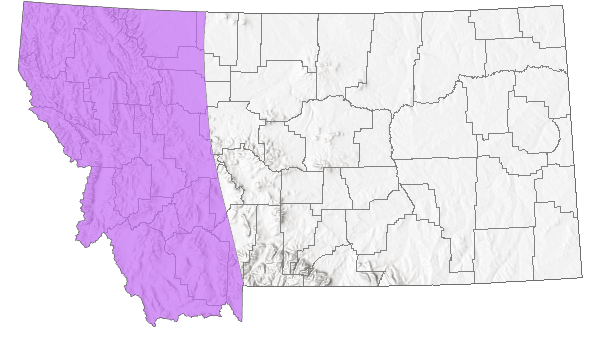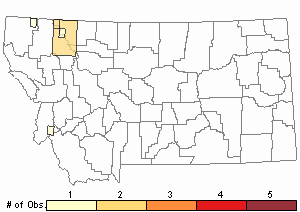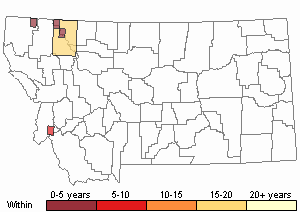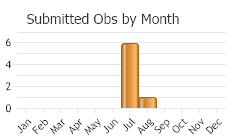View in other NatureServe Network Field Guides
NatureServe
Montana
Utah
Wyoming
Idaho
Wisconsin
British Columbia
South Carolina
Yukon
California
New York
Atlantis Fritillary - Argynnis atlantis
General Description
[From Ferris and Brown 1981, Scott 1986, Glassberg 2001, Guppy and Shepard 2001, Pyle 2002] Forewing 2.2-3.2 cm; a small to mid-sized fritillary. Variable, but typically bright tawny or orange dorsally with strong black spots and "thickened" black veins on forewings, black forewing borders, black scaling at wing bases; ventral hindwing disk usually fairly evenly-colored dark chocolate or milk chocolate brown, spots silver (or ventral hind wing disk reddish-brown and spots usually un-slivered), submarginal band narrow to medium, buffy-yellow crossed by dark veins; eyes blue-gray.
Phenology
One flight, late June to mid-September (Ferris and Brown 1981, Scott 1986, Glassberg 2001, Pyle 2002); early July to mid-August in British Columbia (Guppy and Shepard 2001).
Diagnostic Characteristics
Differentiated by a combination of eye color, dark to black dorsal forewing borders, swollen black regions along veins, and ventral hindwing disk color fairly uniform, not mottled.
Species Range
Montana Range
Range Descriptions

 Native
Native
Range Comments
From Alaska to central California, southern Arizona, and southern New Mexico west of the Great Plains, across southern and boreal Canada to Newfoundland, and south in the northeastern US and Appalachian Mountains; isolated population in the Black Hills, South Dakota (Scott 1986, Guppy and Shepard 2001, Pyle 2002). Mostly common to abundant (Glassberg 2001). In Montana, throughout the state except in some prairie regions (Kohler 1980, Standford and Opler 1993).
Observations in Montana Natural Heritage Program Database
Number of Observations: 7
(Click on the following maps and charts to see full sized version)
Map Help and Descriptions
Relative Density

Recency



 (Observations spanning multiple months or years are excluded from time charts)
(Observations spanning multiple months or years are excluded from time charts)
Migration
Non-migratory.
Habitat
Montane pine forest and spruce-fir forest openings, moist meadows, streamsides (Ferris and Brown 1981, Scott 1986, Guppy and Shepard 2001, Pyle 2002). Xeric and mesic meadows in Glacier National Park (Debinski 1993).
Food Habits
Larval food plants primarily species of Viola. Adults sip flower nectar, particularly Monarda, sometimes feed at mud and dung (Ferris and Brown 1981, Scott 1986, James and Nunnallee 2011).
Reproductive Characteristics
Females lay eggs in mid-August singly and haphazardly near the base of the larval food plant (Viola). Eggs hatch in about 13-14 days, first instar L1 larvae hide on curled leaves and overwinter, L2 instar reached in 7-9 days after exiting hibernation, L2 to pupation in 35-39 days; all instars solitary with no nest, most feeding is nocturnal. Mature larvae silk together leaves close to the ground as a pupation tent; adults eclose about 12 days after pupation. Males patrol throughout the day in open areas, trails, roads, especially moist valley bottoms, in search of females (Scott 1986, James and Nunnallee 2011).
Stewardship Responsibility
References
- Literature Cited AboveLegend:
 View Online Publication
View Online Publication Debinski, D. 1993. Butterflies of Glacier National Park, Montana. Occasional Papers of the Museum of Natural History, the University of Kansas, Lawrence, Kansas. No. 159: 1-13.
Debinski, D. 1993. Butterflies of Glacier National Park, Montana. Occasional Papers of the Museum of Natural History, the University of Kansas, Lawrence, Kansas. No. 159: 1-13. Ferris, C.D. and F.M. Brown (eds). 1981. Butterflies of the Rocky Mountains. Univ. of Oklahoma Press. Norman. 442 pp.
Ferris, C.D. and F.M. Brown (eds). 1981. Butterflies of the Rocky Mountains. Univ. of Oklahoma Press. Norman. 442 pp. Glassberg, J. 2001. Butterflies through Binoculars: A Field Guide to the Butterflies of Western North America. Oxford University Press.
Glassberg, J. 2001. Butterflies through Binoculars: A Field Guide to the Butterflies of Western North America. Oxford University Press. Guppy, C.S. and J.H. Shepard. 2001. Butterflies of British Columbia: including western Alberta, southern Yukon, the Alaska Panhandle, Washington, northern Oregon, northern Idaho, northwestern Montana. UBC Press (Vancouver, BC) and Royal British Columbia Museum (Victoria, BC). 414 pp.
Guppy, C.S. and J.H. Shepard. 2001. Butterflies of British Columbia: including western Alberta, southern Yukon, the Alaska Panhandle, Washington, northern Oregon, northern Idaho, northwestern Montana. UBC Press (Vancouver, BC) and Royal British Columbia Museum (Victoria, BC). 414 pp. James, D.G. and D. Nunnallee. 2011. Life histories of Cascadia butterflies. Corvallis, OR: Oregon State University Press. 447 p.
James, D.G. and D. Nunnallee. 2011. Life histories of Cascadia butterflies. Corvallis, OR: Oregon State University Press. 447 p. Kohler, S. 1980. Checklist of Montana Butterflies (Rhopalocera). Journal of the Lepidopterists' Society 34(1): 1-19.
Kohler, S. 1980. Checklist of Montana Butterflies (Rhopalocera). Journal of the Lepidopterists' Society 34(1): 1-19. Pyle, R.M. 2002. The butterflies of Cascadia: a field guide to all the species of Washington, Oregon, and surrounding territories. Seattle Audubon Society, Seattle, Washington. 420 pp.
Pyle, R.M. 2002. The butterflies of Cascadia: a field guide to all the species of Washington, Oregon, and surrounding territories. Seattle Audubon Society, Seattle, Washington. 420 pp. Scott, J.A. 1986. The butterflies of North America: a natural history and field guide. Stanford University Press, Stanford, California.
Scott, J.A. 1986. The butterflies of North America: a natural history and field guide. Stanford University Press, Stanford, California. Stanford, R.E. and P.A. Opler. 1993. Atlas of western USA butterflies: including adjacent parts of Canada and Mexico. Unpubl. Report. Denver and Fort Collins, Colorado 275 pp.
Stanford, R.E. and P.A. Opler. 1993. Atlas of western USA butterflies: including adjacent parts of Canada and Mexico. Unpubl. Report. Denver and Fort Collins, Colorado 275 pp.
- Additional ReferencesLegend:
 View Online Publication
View Online Publication
Do you know of a citation we're missing? Forister, M.L., C.A. Halsch, C.C. Nice, J.A. Fordyce, T.E. Dilts, J.C. Oliver, K.L. Prudic, A.M. Shapiro, J.K. Wilson, J. Glassberg. 2021. Fewer butterflies seen by community scientists across the warming and drying landscapes of the American West. Science 371:1042-1045.
Forister, M.L., C.A. Halsch, C.C. Nice, J.A. Fordyce, T.E. Dilts, J.C. Oliver, K.L. Prudic, A.M. Shapiro, J.K. Wilson, J. Glassberg. 2021. Fewer butterflies seen by community scientists across the warming and drying landscapes of the American West. Science 371:1042-1045. Forister, M.L., E.M. Grames, C.A. Halsch, K.J. Burls, C.F. Carroll, K.L. Bell, J.P. Jahner, et al. 2023. Assessing risk for butterflies in the context of climate change, demographic uncertainty, and heterogeneous data sources. Ecological Monographs 93(3):e1584. https://doi.org/10.1002/ecm.1584
Forister, M.L., E.M. Grames, C.A. Halsch, K.J. Burls, C.F. Carroll, K.L. Bell, J.P. Jahner, et al. 2023. Assessing risk for butterflies in the context of climate change, demographic uncertainty, and heterogeneous data sources. Ecological Monographs 93(3):e1584. https://doi.org/10.1002/ecm.1584 Layberry, R.A., P.W. Hall, and J.D. LaFontaine. 1998. The Butterflies of Canada. University of Toronto Press. 280 pp. + color plates.
Layberry, R.A., P.W. Hall, and J.D. LaFontaine. 1998. The Butterflies of Canada. University of Toronto Press. 280 pp. + color plates.
- Web Search Engines for Articles on "Atlantis Fritillary"
- Additional Sources of Information Related to "Insects"





